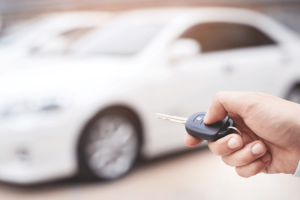
- The Savvy Promise
At Savvy, our mission is to empower you to make informed financial choices. While we maintain stringent editorial standards, this article may include mentions of products offered by our partners. Here’s how we generate income.
In this article
Test driving a car is an essential step in the car-buying process. It offers you the chance to experience firsthand how a vehicle performs on the road and whether it meets your expectations and requirements. However, to make the most out of your test drive, it's crucial to know what to look for and how to assess various aspects of the vehicle. In this comprehensive guide, we explore the key factors to consider when test driving a car, from performance and handling to comfort and safety features.
Step 1: Research and prepare
- Research the car: familiarise yourself with the specific car model you’re interested in, including reading reviews and noting down key features.
- Know your needs and priorities: consider your lifestyle, driving habits and passenger/cargo requirements. Are you looking for fuel efficiency, comfort for long commutes or sporty handling? Prioritise the features most important to you.
- Prepare a checklist: create a checklist of aspects you want to evaluate during the test drive. This could include interior space, comfort features, technology functionalities, visibility and driving dynamics. Don't forget to jot down any specific concerns you want to address.
- Don’t forget your licence: you will be required to show your driver’s licence to test drive the car.
Step 2: Schedule the test drive
Once you've identified the vehicle(s) you want to test drive, book appointments with the dealerships. You can usually do this by phone, though many places now offer online booking systems. If possible, you may want to schedule test drives for multiple vehicles on the same day, so you can compare them more easily. Make sure to allocate enough time for each test drive to thoroughly evaluate the vehicle. Some dealers may even allow you to borrow the car for a longer period up to 24 hours.
Step 3: First impressions
- Exterior inspection: take a close look at the exterior of the car. Check for any dents, scratches or paint imperfections. Inspect the condition of the tyres and look for signs of uneven wear, which could indicate alignment issues. Ensure that all the lights, including headlights, taillights and turn signals, are functioning correctly.
- Interior features: once inside the car, take note of the overall comfort and ergonomics of the interior. Adjust the seats, steering wheel and mirrors to your liking. Pay attention to the quality of materials used in the cabin and the layout of the controls. Test out the infotainment system, climate controls and other features to ensure they are intuitive and easy to use.
Step 4: The drive
The most crucial part of the test drive is evaluating how the car performs on the road. Pay attention to:
- Engine: listen for any unusual noises or vibrations. Listen to the smoothness of the engine start-up.
- Acceleration: merge into traffic and test the car's pick-up and power. Does it feel sluggish or responsive? Pay attention to turbo lag if applicable.
- Handling: turn corners and try different types of roads. How does the car handle curves and maintain stability? Does it inspire confidence in your ability to manoeuvre?
- Braking: test the brakes in a controlled manner at varying speeds. Ensure they feel firm and responsive without any pulling to one side.
- Steering: evaluate the steering feel. Is it light and responsive or heavy and requiring more effort? Does it provide good feedback on road conditions?
- Ride quality: drive over different road surfaces, including potholes and bumps. Assess the car's ability to absorb bumps and maintain a comfortable ride. Is it excessively noisy or smooth and quiet?
Step 5: Consider other features
Beyond the drive itself, think about:
- Cargo space: open the boot or cargo area. Is there sufficient space for your needs? Consider the ease of loading and unloading groceries, luggage or sports equipment.
- Fuel efficiency: ask about the car's fuel economy ratings and compare them to your research findings. If possible, take note of the fuel consumption during your test drive.
- Safety features: inquire about the car's safety features, including airbags, traction control, blind-spot monitoring and automatic emergency braking (AEB), and if possible test them during the drive.
Step 6: Final impressions and questions
After completing the test drive, take some time to reflect on your experience and impressions of the vehicle. Did the car meet your expectations in terms of performance, comfort and features? If you have any lingering questions or concerns, don't hesitate to ask the salesperson for clarification. Also take into account:
- Cost of ownership: research the car's insurance costs, scheduled maintenance requirements and estimated fuel expenses. Factor these costs into your overall car budget.
- Availability and service: check the availability of the specific car model in your area. Also, research the reputation and service quality of the dealership's service department.
- Warranty coverage: understand the warranty coverage offered by the manufacturer and the dealership. Look for warranties that cover major components and offer peace of mind.
If you are happy with the car and coverage, you can start negotiations to make it yours!
Can I test drive a car from a private seller?
Yes, you should be able to test drive a car from a private seller in Australia! However, it's important to take some extra precautions to ensure your safety and a smooth transaction. Here's a breakdown of what to keep in mind:
Safety first:
- Bring a friend: don't go alone. Inform someone of your plans and meeting details.
- Public place: meet in a public area during daylight hours.
- Verify ownership: check the car's title, registration and seller’s ID for a match. Consider a vehicle history report.
During the drive:
You should follow the same test drive strategies outlined earlier. It is common for the seller to accompany you during the test drive but some sellers may insist on driving the car themselves. If this is the case, politely explain your preference to be behind the wheel to fully evaluate the car. If they refuse, consider it a red flag and walk away.
Additional tips:
- Independent inspection: before finalising the purchase, consider getting the car inspected by a certified mechanic. This can uncover any hidden problems and provide valuable insights into the car's condition.
- Don’t feel pressured: don't feel you must buy the car just because you test drove it. Take your time, gather your thoughts and compare your options before making a decision.
- Trust your gut: pay attention to your intuition. If something feels off about the seller or the car, continue your search elsewhere.
Test driving a car is a crucial step in the car-buying process, allowing you to assess the vehicle's performance, comfort and features for yourself. By following these tips and guidelines, you can make the most out of your test drive experience and make an informed decision when choosing your next vehicle. And if you're in need of financing for your new car purchase, Savvy is here to help you find the right loan option tailored to your needs and budget. Get started with a car loan through Savvy today!
Did you find this page helpful?
Author
Adrian EdlingtonReviewer
Bill TsouvalasPublished on December 1st, 2020
Last updated on March 28th, 2024
Fact checked
This guide provides general information and does not consider your individual needs, finances or objectives. We do not make any recommendation or suggestion about which product is best for you based on your specific situation and we do not compare all companies in the market, or all products offered by all companies. It’s always important to consider whether professional financial, legal or taxation advice is appropriate for you before choosing or purchasing a financial product.
The content on our website is produced by experts in the field of finance and reviewed as part of our editorial guidelines. We endeavour to keep all information across our site updated with accurate information.
Approval for car loans is always subject to our lender’s terms, conditions and qualification criteria. Lenders will undertake a credit check in line with responsible lending obligations to help determine whether you’re in a position to take on the loan you’re applying for.
The interest rate, comparison rate, fees and monthly repayments will depend on factors specific to your profile, such as your financial situation, as well others, such as the loan’s size and your chosen repayment term. Costs such as broker fees, redraw fees or early repayment fees, and cost savings such as fee waivers, aren’t included in the comparison rate but may influence the cost of the loan. Different terms, fees or other loan amounts may result in a different comparison rate.









